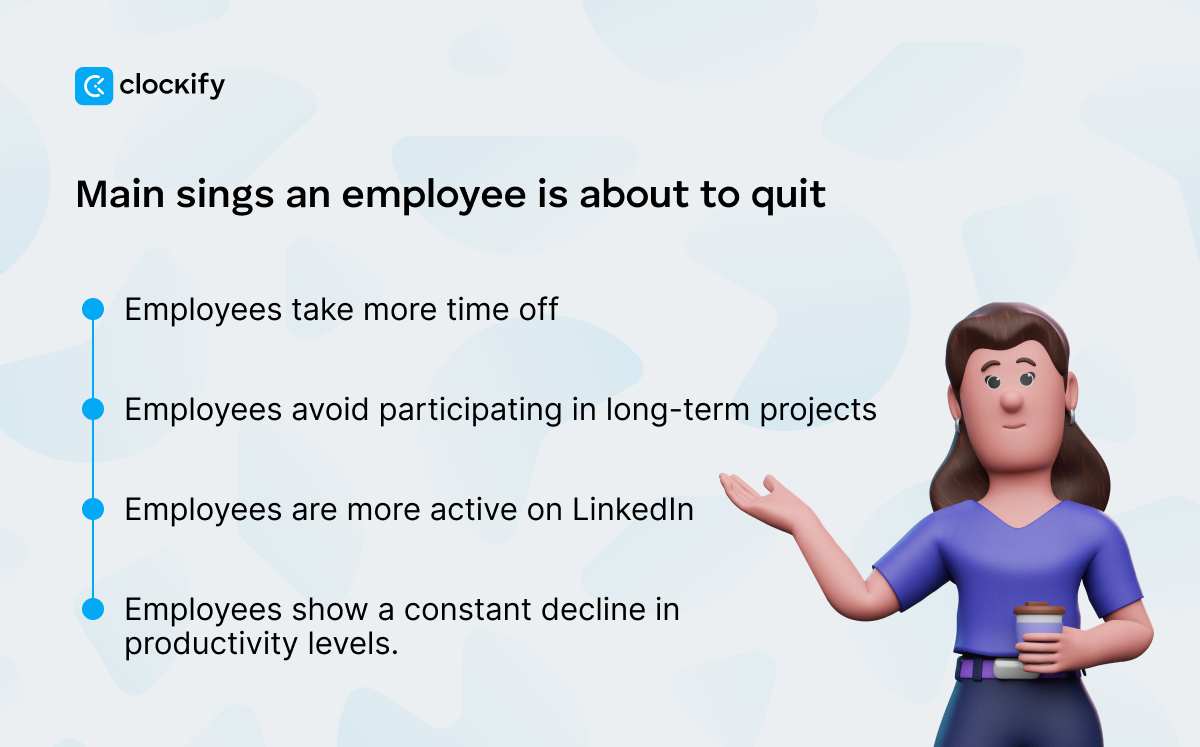Have you noticed subtle changes in your employees’ behavior?
Perhaps they seem disengaged or easily irritated. Maybe, they’re on their third sick leave this month and are also planning a vacation.
While there may be a logical explanation for these situations, they also represent some of the main signs an employee is about to quit.
That’s why we’ve compiled a list of the most common indicators that an employee may leave and added some super-efficient retention strategies to support you.

What are the main signs an employee is about to quit?
Let’s dive deeper into the key hints that your employees may be actively looking for a new position elsewhere.
#1: Employees take more time off than usual
Employees who are about to quit often use more PTO before handing in their resignation.
How so?
Well, job interviews usually occur during business hours, so employees have to get out of work to attend them. Additionally, interviews consisting of several rounds take longer to complete, thus requiring more time off work.
Likewise, it’s common for workers to try to avoid a toxic atmosphere by taking unprompted sick leaves — or inquiring about last-minute time off policies.
💡 CLOCKIFY PRO TIP
Having a time off policy will make it easier for both you and your employees to keep track of days when your team members aren’t working. Here are some useful articles to find out more about it:
#2: Employees avoid participating in long-term projects
Has your star employee suddenly lost interest in one of your latest long-term projects?
An employee leaving their job doesn’t see themself as part of the company’s future and will often avoid participation in assignments that may take weeks or months to complete.
This could be because of their active job hunt and the fact that they don’t want to spend energy on new projects.
Of course, this isn’t necessarily the only cause — they may have some personal matters going on — but it’s one of the warning signs.
💡 CLOCKIFY PRO TIP
To complete all of your projects on time and deliver them successfully to clients, it’s vital to track them:
#3: Employees are more active on LinkedIn than usual
As per statistics, 7 people get hired every minute on LinkedIn. Chances are you’ve also found your current staff on this popular social network.
So, if employees suddenly become active on LinkedIn, they may be searching for a new job opportunity.
Have you noticed someone from your company posting more frequently or enhancing their LinkedIn profiles to match potential jobs?
Lastly, it’s important to observe the signs an employee is about to quit so that you don’t have to wonder what to do when an employee quits suddenly.
#4: Employees show a constant decline in productivity
Anyone can have a bad day or a week when they’re not fully productive — it doesn’t have to imply a team member is leaving their current job.
But, if you notice a consistent drop in productivity combined with missed deadlines and low engagement levels — an employee announcing their departure is probably just a matter of days or weeks.
While this is one of the signs an employee is about to quit, you might also experience so-called quiet quitting. In this scenario, the worker doesn’t intend to quit but plans to do the bare minimum without getting fired.
Business owner Allan Wille helps us discern various signs by explaining that if there’s an abrupt change in an employee’s behavior — the worker has probably decided to quit:

“A shift in demeanor that is not only sudden but also compulsive almost always is an alarm to management that an employee seeks to resign.”
💡 CLOCKIFY PRO TIP
Tracking time is one of the proven techniques that boost productivity without causing stress to employees. Read more about it in the following blogs:

Strategies to prevent an employee leaving the job
Here are some of the most efficient strategies to keep your employees happy with their current jobs.
#1: Don’t overburden your workers
Once employees decide to quit, it may be too late to convince them to stay.
That’s exactly why prevention is one of the best retention strategies. Employees who aren’t overburdened and constantly rushed are far less likely to seek other opportunities.
To get straight to the chase, here’s how you can prevent burnout:
- Set a daily work capacity limit — define the maximum number of work hours your employee can spend on a project per day,
- Distribute projects and tasks evenly — avoid situations where some of your employees have too many tasks while others are bored, and
- Set SMART goals — create goals that are specific and achievable, with a deadline your employees can meet.
Finally, stay alert for warning signs that a departing employee may exhibit — catching these signs early can help you take corrective action. In this way, you’ll never need to think about what to do when an employee quits suddenly.
💡 CLOCKIFY PRO TIP
Learn more about the effects of burnout that go beyond the mere job change:
#2: Have 1:1 meetings with employees
Our interlocutor expert Allan Wille says that open communication is the best approach to potential employee leaving:

“In order to motivate workers to remain in the organization, problems and areas of resignation have to be openly addressed. Structured one-on-one interactions can give each member of the organization a chance to communicate and be listened to.”
If you haven’t already, we recommend organizing monthly 1-on-1 meetings with your employees. In these meetings, you can discuss employees’ progress and any issues that may bother them.
Sometimes, the only thing needed to prevent an employee’s departure is to offer a position change, different scheduling options, or some other incentive.
The only way to learn what team members need from you is to invest time in open conversations with them. This is the best method to avoid situations when an employee quits because of you.
💡 CLOCKIFY PRO TIP
If your employees need to work in non-traditional shifts, it’s important to know what you can offer them. Read more about different scheduling options here:
#3: Provide your employees with opportunities for growth
Employees may also leave when they don’t have opportunities for growth and personal development. In fact, a Pew Research Center survey found that 63% of US employees quit due to career stagnation.
If possible, present your employees with a growth opportunity and a clear career advancement plan. Staying in one place with no room to grow is a sign to team members that it’s time to move on.
They’ll interpret stagnation also as one of the signs that your boss wants you to leave, and may also obsess with questions such as how to know when to quit.
Entrepreneur Allan Wille goes even further as he suggests giving team members experiences and demands that surpass work itself:

“Getting something done for their career goals is one thing, getting things for their life goals is another, and helps form a strong relationship with the organization. Provide employees with opportunities to learn new skills and take on new challenges. Such kind of real encouragement gets rid of thoughts of exit and guarantees progress and efficiency for both sides.”
Use Clockify to retain your employees
Assigning projects in ways that engage rather than overwhelm employees, along with scheduling 1 on 1 meetings, are vital retention strategies.
To successfully implement them, rely on Clockify, our easy-to-use time tracking tool that is also perfect for scheduling.
Track project time using multiple methods, including:
- Timer — track how many hours your employees spend on a certain activity by starting a timer,
- Kiosk — clock in and out from a shared device (ideal for out-of-office positions), or
- Timesheet — enter time manually and specify hours worked on a specific project or task.
By scheduling projects with Clockify, you’ll gain real-time visibility into who has available capacity and who is overloaded with work hours.
You can even use the integrations feature to connect the tool with Google Calendar and make scheduling even easier.

The best part?
You can try this powerful tool using a completely free version for your creative agency or construction company — it works like a charm in any industry.
The free version includes unlimited:
- Reports,
- Time tracking,
- Number of users, and
- Pomodoro timer, among other useful features.
You can also help your business stay compliant, as Clockify boasts GDPR compliance, SOC2 report, and ISO certificate.
Let’s retain your employees together.


